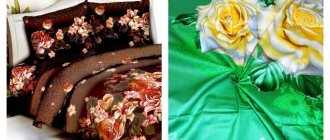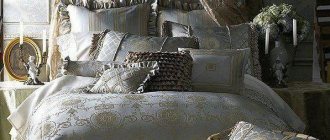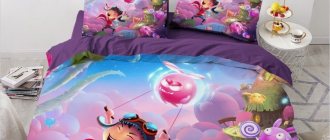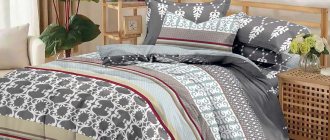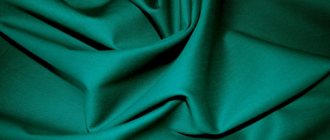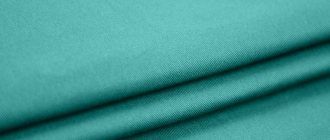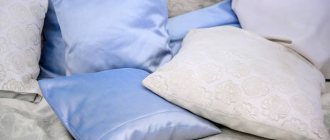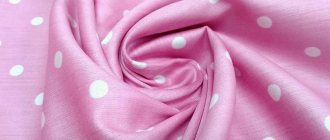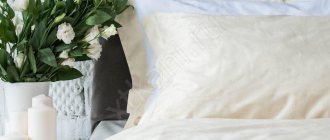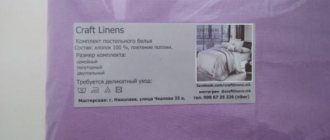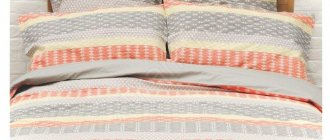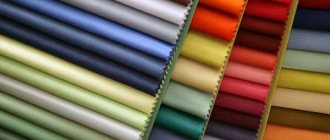One of the varieties of jacquard satin is stripe satin.
This is a fabric whose weaving consists of alternating stripes , hence the name of the material: stripe means “strip” in English.
In terms of its properties, stripe satin is not much different from jacquard, and the main feature of this fabric is its pattern: the characteristic stripes are obtained not by printing, but by a special interweaving of threads.
Description and composition
Photo No. 3 Champagne
Unlike jacquard, which is dominated by “floral” motifs, stripe satin is a more “strict” fabric.
Regular geometric shapes and patterns prevail here , but such material cannot be called monotonous and inexpressive: various combinations of stripes and patterns allow manufacturers to create ever new attractive and relevant models.
In the production of stripe satin, only natural dyes , which are not applied to the finished material, but are used to color individual threads before weaving.
As a rule, soft light colors are used to make stripe satin, but exotic bright models are often found.
Stripe satin consists of 100% cotton, which makes this fabric soft and pleasant to the touch, but at the same time dense and wear-resistant.
Characteristic
Satin fabric can be made from artificial, cotton or other threads, but a special weave of fibers is always used. One part of the fabric has a slight sheen and is smooth, while the other is dominated by weft threads and the surface is pale in color and does not shine.
Satin quality weave is characterized by the property that the cross-type thread (weft) intersects the warp threads with a pitch of 4:1. As a result, the front side is smooth, soft and silky. For satin, double twisted threads are used, which allows you to create a reliable and wear-resistant material.
The implementation of this weaving method makes it possible to obtain satin fabric, the characteristics of which are as follows:
- resistance to wear, friction, stretching, temperature influences;
- pleasant shine of the smooth surface;
- easy cutting of fabric, ease of sewing products of varying complexity;
- wide scope of application;
- the ability to combine satin and other fabrics;
- The density of interwoven fibers can range from 85 to 220 pieces per 1 cm2.
Satin material is considered practical, because manufacturers often add elastane fibers to improve properties, for example, wear resistance. At the same time, products, for example, bed linen, can easily be properly treated with bleaches, last for many years and practically do not lose their original appearance, which is why satin is popular. After washing, bedding sets and other items do not lose their shape, which is the most important of all properties.
This is interesting: Chambray fabric: what kind of material is it, similarities, properties
Advantages and disadvantages
pros
Stripe satin has the same advantages as satin:
- Natural 100% cotton in stripe sateen makes it pleasant to the touch, and linen made from this material ensures a comfortable sleep;
- Stripe weaving makes the fabric durable and wear-resistant; this material is designed to last several hundred washing cycles ;
- This is a hypoallergenic material that does not cause irritation on the body, making stripe-satin bed linen ideal for people suffering from allergic reactions when using modern synthetic fabrics.
Minuses
- The disadvantages of stripe satin include the use of bed linen made from such material in the summer: some people claim that sleeping on such a bed on summer nights is very hot , but the point here is rather a matter of personal perception, since many consumers do not see such a problem.
Types of fabric
Classic stripe satin. The original version of this fabric is made of pure cotton.
- Mixed option. Manufacturers can still add various synthetic fibers to cotton: polyester, elastane or polyester. Typically, the share of synthetics is not more than 10 percent, since with a high content of such fibers, stripe-satin begins to electrify and becomes hard rather than silky.
However, there are mixed variations made only from natural fibers, for example, mycosatin. This soft fabric is made from cotton, to which bamboo or eucalyptus fibers are added. Wood threads are safe for allergy sufferers and people with sensitive skin. Mycosatin is thinner than classic stripe satin, so the level of breathability is much higher. In addition, the fabric absorbs water better.
How to choose stripe satin
Stripe satin is used for sewing various products:
- Bed sheets;
- Shirts;
- Underwear;
- Dresses;
- Curtains;
- Tablecloths;
- This material is also used as lining fabric.
Photo No. 5 Red sheet with an elastic band
At the same time, the consumer often does not purchase finished products, but looks for the material itself for sewing the products themselves. In this case, you should approach the choice of fabric especially carefully and, first of all, you should pay attention to the density of stripe satin.
This value is indicated on the packaging and can be indicated either in the number of threads per centimeter or in grams per square meter.
Indicators from 110 to 180 threads per centimeter or 120 grams per square meter are considered optimal.
If for some reason this information is missing, it is easy to determine the density by looking through the fabric into the light: through good quality fabric, even in bright light, only vague silhouettes of people standing nearby or nearby objects will be visible.
If the outlines of objects are clearly visible, the density of stripe satin is insufficient.
Sometimes the product may have a mark indicating that the fabric has been mercerized (special treatment). This is always an advantage, since the fabric that has undergone this process will retain its shine longer and will not fade after several washes.
Bottom line
In this article we found out that this is stripe satin. It also became clear that this material looks very elegant and stylish.
The material is thin and at the same time durable; it can withstand a fairly large number of industrial washing cycles and ironing without losing the strength of the fabric and the brightness of the color. The excellent hygienic properties of cotton, its ability to cool in the heat and warm in the cold, the silky surface, which, among other things, does not stick to the skin and does not slip - all this is reason to consider striped satin a very prestigious material.
In addition, the environmental friendliness and naturalness of high quality cotton fabric makes it an excellent choice for people who suffer from allergies or have hypersensitive skin. Non-flowability is a pleasant feature of this material; it is also easy to sew and cut, although in most cases ready-made products go on sale.
Care
Stripe-satin is an unpretentious material, however, when caring for it, you must follow the following rules and recommendations:
- Products made from stripe satin are washed separately from other fabrics .
- The water temperature for washing should not exceed 40 degrees .
- be turned inside out before washing .
- When washing colored stripe satin, only products that do not contain bleaching components are used.
- Stripe satin should be ironed only from the inside out , and the linen should be slightly damp.
Manufacturing
To create a fabric with a satin weave, cotton threads are used, but sometimes manufacturers also use synthetic options. Combinations of different raw materials are possible, but the main role is played by compliance with the fiber placement technique. The threads are intertwined as follows: two threads, one denser one, is placed on the important base of the fabric, and the twisted and thin one is used to form the front outer side. The pronounced shine of the material depends precisely on the twist of the thread, because the tighter it is twisted, the more it shines. Thus, for four elements of the purl type, one front one is used.
Many people are interested in the question of what stripe satin is or what fabric options there are. The creation technology of the satin material allows us to obtain the following types of fabrics:
- Mako is considered one of the most durable options, as it has a high density. To create mako fabric, thin and high-quality cotton elements are used;
- jacquard is characterized by the fact that it does not have a reverse side, because when weaving, thin versions of threads and a special weaving method are used, which creates a fabric with a pattern on each side;
- high quality silk fabric, created with satin weaving, has the reverse side made of satin, and the front side is made of silk;
- crepe contains raw silk, and the finished fabric is similar to satin, distinguished by shine, smoothness, and strength;
- To answer the question of what high-density stripe satin is, you should know that this common material is characterized by stripes or simple geometric patterns that differ in the level of shine, but are of the same color. For production, high-quality, thin cotton with a density of 120 g/m² or more is used;
- twill-satin differs from ordinary satin in that in the first case the manufacturing and weaving is characterized by a step of one thread element to three, and in the second - two to two. The result is a dense and durable structure of threads;
- The answer to the question of what microsatin is requires knowledge of the structure. Microsatin is a lightweight fabric made from a mixture of cotton, bamboo, viscose and polyester.
Manufacturers produce different types of fabrics for textiles and linen, but each of them has certain characteristics and requires proper care.
This is interesting: Technical fabrics: basalt, silica, asbestos, properties, application
Photo gallery
Photo No. 1 Monogram Photo No. 2 Photo No. 3 Champagne
Photo No. 4 Snow-white Photo No. 5 Red sheet with elastic
Photo No. 6
Photo No. 7 Purple
Photo No. 8 Pistachio
What is made from it
stripe-satin-7
stripe-satin-8
stripe-satin-9
stripe-satin-10
This type of satin is used for sewing various things:
- home textiles - bed linen, tablecloths, towels, curtains, bedspreads;
- lining for expensive outerwear;
- men's and women's shirts;
- dresses for girls and women;
- underwear;
- women's and men's business suits.
Bed linen made of thick white fabric is used in expensive hotels and sanatoriums. It is easy to care for and can be steam ironed.
Typically, buyers try to purchase not a finished product, but a piece of fabric. They are already making the necessary thing out of it. Therefore, you need to choose the right material.
Pay attention to tailoring
The presentable appearance of products, their durability and resistance to increased loads depend on the quality of tailoring.
The Topico company offers calico bed linen
wholesale, as well as bedding made of satin, poplin and percale, sewn by professional craftsmen on modern factory equipment in compliance with all technological standards and requirements for products for the hotel business. When choosing bed linen for a hotel, keep in mind that a conscientious supplier offers products of impeccable tailoring quality, in which:
- product shrinkage is set by default;
- in their production, strong, durable threads were used, resistant to intense loads, chemicals for bleaching, and high temperatures when washing;
- the requirements for bending the material and allowances are met;
- The stitch pitch is selected taking into account high operational requirements.
Reviews
Karina:
I purchased a set of bed linen on the advice of the seller and did not regret it. It is easy to wash and can be ironed using a burst of steam, even after several layers. Soft, pleasant linen that does not wrinkle, has a neutral shade and decorates the bedroom. A small drawback is that it slips and you have to wear pajamas.
Pauline:
I sewed curtains from this fabric and couldn’t be happier. It shines beautifully in the light and is dense enough not to let color through. Curtains are as simple as possible to care for - ordinary washing and ironing restores their attractiveness and removes dirt.
Do you have any more questions? You were able to make sure that the fabric has excellent characteristics and will become a real decoration for your home or wardrobe.
